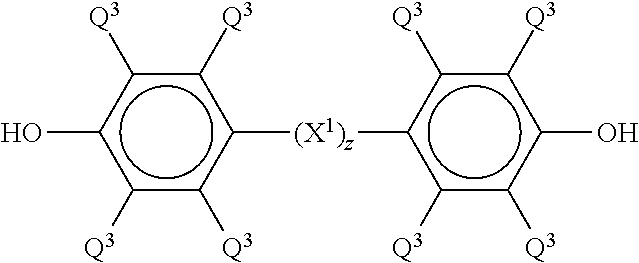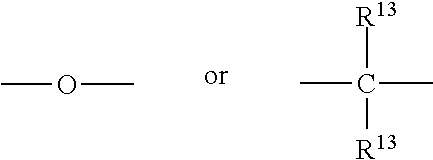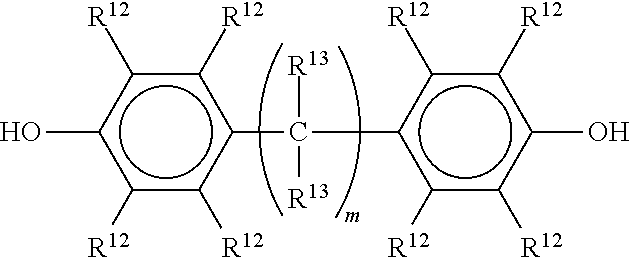Varnish compositions for electrical insulation and method of using the same
a technology of varnish composition and electrical insulation, which is applied in the direction of plastic/resin/waxes insulators, dyeing process, coatings, etc., can solve the problems of varnish chipping or cracking, significant thermal degradation, and more frequent maintenance intervals than desired
- Summary
- Abstract
- Description
- Claims
- Application Information
AI Technical Summary
Benefits of technology
Problems solved by technology
Method used
Image
Examples
example 1
Preparation of Low Intrinsic Viscosity Methacrylate Capped Poly(Phenylene ether) using Benzoyl Peroxide
[0114]In this example a peroxide compound was used as a redistribution catalyst for 10.0 grams of poly(phenylene ether) (SA120 available from SABIC Innovative Plastics in Selkirk N.Y.) having an intrinsic viscosity of 0.12 deciliters per gram, measured at 25° C., a weight average molecular weight of 7100, and a number average molecular weight of 2700. These materials were dissolved in 14 milliliters of vinyl toluene at 80° C. To this was added 0.6 gram of bisphenol A and 0.6 gram of benzoyl peroxide (BPO). (The addition of the BPO is exothermic, so that portions of the BPO can be added over time to limit the increase in temperature when carrying out the process on a larger scale.)
[0115]The resulting composition was heated with stirring for 3.5 hours at a temperature of 90° C. At this point, gel permeation chromatographic (GPC) analysis in chloroform of a small sample showed the red...
example 2
Preparation of Low Intrinsic Viscosity Methacrylate Capped Poly(phenylene ether) using 3,3′,5,5′-Tetramethylphenoquinone
[0117]In this example, a quinone compound was used as a redistribution catalyst for 10.0 g of poly(phenylene ether) (SA120 available from SABIC Innovative Plastics in Selkirk N.Y.) having an intrinsic viscosity of 0.12 deciliters per gram, measured at 25° C., and a weight average molecular weight of 7100 and a number average molecular weight of 2700. These materials were dissolved in 14 mL of vinyl toluene at 80° C. To this was added 1.0 g of bisphenol A and 250 mg of 3,3′,5,5′-tetramethyldiphenoquinone (TMDQ). The result was heated with stirring overnight at a temperature of 85-90° C. At this point, GPC (gel permeation chromatography) in chloroform (using polystyrene standards) of a small sample showed the redistributed polymer to have a number average molecular weight (Mn) of 1848 and a weight average molecular weight (Mw) of 4087.
[0118]Next, 3.5 milliliter of me...
example 3
Preparation of Low Intrinsic Viscosity Methacrylate Capped Poly(Phenylene ether) using Benzoyl Peroxide and (1,1,1-Tris(hydroxyphenyl)ethane)
[0119]In this example a quinone compound was used as a redistribution catalyst, as in Example 2, but using THPE (1,1,1-tris(hydroxyphenyl)ethane) instead of bisphenol A to prepare a trifunctionalized capped poly(phenylene ether) instead of a bifunctionalized capped poly(phenylene ether).
[0120]First, 10.0 grams of poly(phenyl ether) (SA120 available from SABIC Innovative Plastics in Selkirk N.Y.) was obtained, having an intrinsic viscosity of 0.12 deciliters per gram, measured at 25° C., a weight average molecular weight of 7100, and a number average molecular weight of 2700. This was dissolved in 14 mL of vinyl toluene at 70° C. To this was added a solution of 700 milligrams of 1,1,1-tris(hydroxyphenyl)ethane (THPE) in 2 milliliters methanol. Next, 700 milligrams of benzoyl peroxide was added, and the temperature was increased to approximately ...
PUM
| Property | Measurement | Unit |
|---|---|---|
| wt. % | aaaaa | aaaaa |
| temperature | aaaaa | aaaaa |
| Tg | aaaaa | aaaaa |
Abstract
Description
Claims
Application Information
 Login to View More
Login to View More - R&D
- Intellectual Property
- Life Sciences
- Materials
- Tech Scout
- Unparalleled Data Quality
- Higher Quality Content
- 60% Fewer Hallucinations
Browse by: Latest US Patents, China's latest patents, Technical Efficacy Thesaurus, Application Domain, Technology Topic, Popular Technical Reports.
© 2025 PatSnap. All rights reserved.Legal|Privacy policy|Modern Slavery Act Transparency Statement|Sitemap|About US| Contact US: help@patsnap.com



